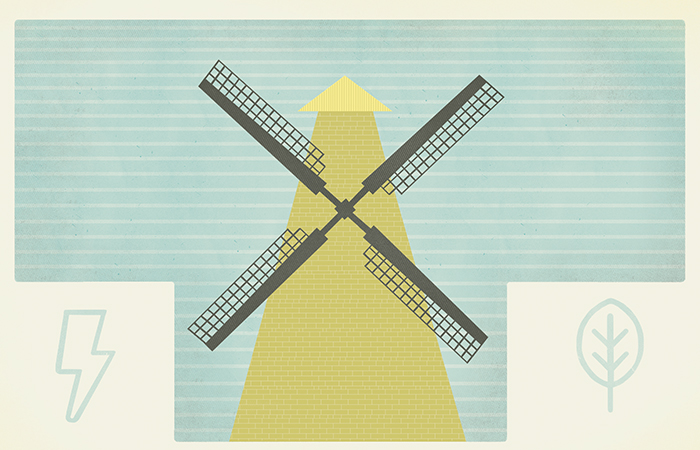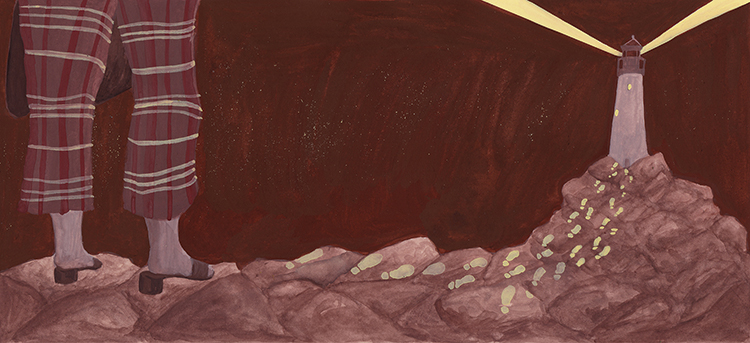Illustration by Kathleen White
Blowing in the Wind
by Jerry Silberman
Question: Is large-scale renewable electricity production sustainable?
The Right Question: Is renewable energy the future for human society?
The recognition that burning fossil fuels may burn us out of the planet’s ecosystem has made the abandonment of fossil fuel resources the right choice, regardless of how much remains buried in the ground. We must begin switching over to electricity generated from the sun and from wind as soon as possible if we hope to avoid catastrophic climate change.
Did you notice the equation of “energy” and “electricity” in the questions above? Probably not, because most public discussion about renewables is only about electricity. However, only one-third of the energy we use comes in the form of electricity. Most energy use comes overwhelmingly from direct fossil fuel consumption—gasoline, jet fuel, natural gas for cooking and heating—which means that travel and our home lives need to be rethought.
Nevertheless, since fossil fuels also generate the majority of our electricity, moving to sustainable, renewable electric generation would be a step in the right direction to limit global warming.
But we need to understand that “renewable” and “sustainable” mean very different things. Renewable sources of energy are those reproduced day in and day out by the elemental forces bringing energy to our planet—primarily sunlight, but also gravitation, expressed in tides and the rotation of the planet on its axis and in its solar orbit. The motions of air and water, the heat and light arriving from the sun, are concentrated energy forces that we may capture to do useful work for us.
However, they are never as concentrated as fossil fuels, where chemical and geological processes have taken eons to distill the energy. Unlike fossil fuels, these renewable energies will be available for billions of years, but we can only get a limited amount every day. Renewable energy is the goose that lays the golden eggs: one each day, as long as we don’t get greedy.
Sustainable energy uses renewable energy without depleting non-renewable resources. Unfortunately, large-scale energy projects require massive amounts of fossil fuels. Is it really a sustainable generating system to have a windmill 150 feet high—or 500 feet high, as are some now planned off the shore of Scotland—using thousands of tons of concrete, steel and fiberglass (or high-tech plastic) for its vanes, placed offshore by a huge construction ship operated by a diesel motor? Without a variety of machines that burn fossil fuels, and the substantial greenhouse gases they emit, its construction is impossible.
While the windmill will generate a lot of electricity over its lifetime, the electricity it generates cannot power the processes needed to manufacture a replacement windmill when it reaches the end of its useful life. This technology is a one-hit wonder.
Much smaller windmills, built of local stone and wood, with some iron in their gears and drivetrain, have, in the past, done much more than grind flour. They have made paper, woven cloth, sawed wood and performed many other complex tasks. The direct harvest of mechanical energy to run machinery can be used with incredible versatility. At the end of their lifetimes, such machines can leave the world as they found it, having done extensive useful work over decades—perhaps centuries—with essentially no consumption of non-renewable resources.
The output of such machines is necessarily less than their giant, fossil-fuel-subsidized cousins, but that is why they are sustainable. Only if we accept serious limits on the amount of energy at our disposal can we get to the point where we rely on renewable energy, sustainably generated.
Using wind energy directly to power tasks that we need is a more efficient use than producing electricity. Why generate electricity to run a faraway motor or water pump, when the work could be done directly where the power is created? Resources and energy are saved. It will be our choice to use some of that wind power to generate electricity where there is no alternative, for example, for lighting.
Learning to live within a sustainable budget of electricity will prove to be our biggest challenge in combating climate change.
Jerry Silberman is a cranky environmentalist and union negotiator who likes to ask the right question and is no stranger to compromise.









hello. I don’t usually write in but your recent issue concerning nuclear power has me alarmed. by the way, I usually like your magazine, but this article in your latest issue is just not done from an unbiased and well informed perspective. any casual perusal should have any semi intelligent person concerned with the real harm from nuclear energy. sure, if done properly, each and every day, perhaps it can be used safely. but as time and incidents such as fukushima-which is still going on today and is getting ever worse, its just not worth the risk. I think this article is bs and you do an ill service to the environment with this garbage. did anyone even bother to look into any of the accidents that are going on right this minute around the world? how about how destructive and long term some of the radioactive isotopes are? anything besides the usual self invested party line bs? apparently not. anyways, thanks for helping to kill the world through your ignorance. thanks for helping to lead the masses down that same road of destruction. hope you enjoy the cancer from the safe radiation. s